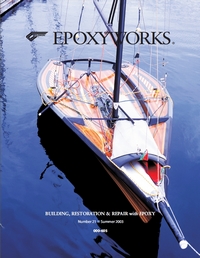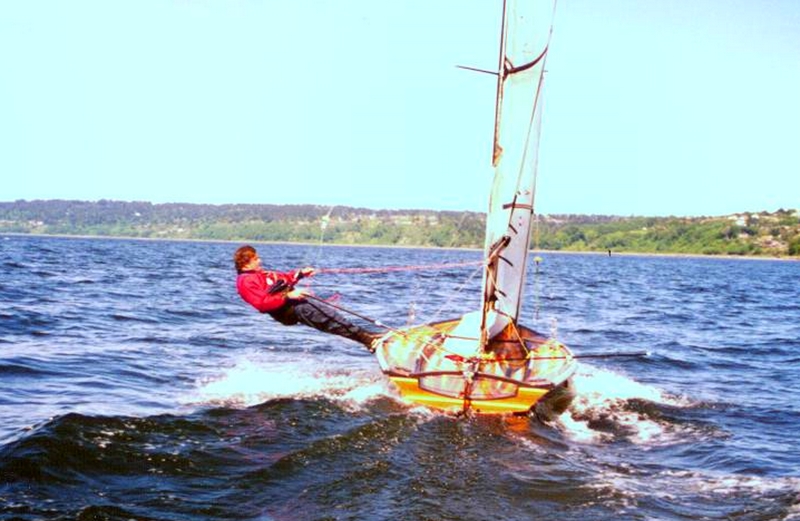
by Meade Gougeon — GBI Founder
Above: The singlehanded sailing skiff SWIFT SOLO by Bram Dally was part of his design quest to prevent loss of stiffness in small boats.

One of the little-known or understood characteristics of modern fiber-reinforced plastic composites is the loss of some initial stiffness capability after repeated cyclic loading. Loss of stiffness can be significant enough to cause a noticeable effect on performance, depending upon laminate makeup and degree of cyclic loading.
Loss of initial stiffness after repeated cyclic loading was first noticed in several highly competitive racing dinghy classes where older boats that had been sailed hard for several seasons lost enough of their original stiffness to become no longer competitive with newer boats. The cause of the problem is directly related to the common manufacturing method for GRP composites of laying down fibers into a wet resin. Unfortunately, there is no practical way to pretension these fibers or even assure that they are laid in a straight path before the resin is fully cured. To react properly to a load, the fibers must strain (or stretch) to some degree depending upon fiber type. This strain rate can be significant and damaging, especially in cyclic loading on lightweight laminates that are pushing the edge, as is common in modern dinghy and beach-cat racers. As load cycles build up over time, microcracking begins in the resin matrix immediately surrounding the fibers as they adjust their position in the matrix in response to load. The high load-bearing fibers ultimately find equilibrium and stabilize in both tension and compression, and then usually provide a long working lifespan.
The only problem is that the laminate has lost some part of its original stiffness, which may be enough to affect the desired competitive performance of the structure. A lot of variables affect the degree of stiffness loss. The following are the most important:
- Basic fiber stiffness: S-glass is 20% stiffer than E-glass, carbon is twice the stiffness of S-glass, etc.
- Fiber preparation: Unidirectional and stitched fiber layers are stiffer than woven types.
- Laminate design: More conservative laminates (more material), designed for a given load, will not have to strain (or stretch) as far, which reduces the micro-cracking phenomena.
- Resin type: Typical polyester-type resins are not as good as well-conceived epoxy-based resins, which are both tougher and stronger in their ability to limit matrix debonding and associated stiffness loss.
- Wood use in high load areas: Nature’s great composite has one outstanding characteristic that is not fully appreciated. In cyclic loading, wood loses no stiffness up to the point of failure. Loads can be a very high percent of wood’s ultimate capability over many cycles. A good example of wood’s natural ability to maintain its original stiffness can be found in the 17′ Thistle class racing sailboat designed by Sandy Douglass just after World War II. Several hundred of the original boats were hot molded of mahogany veneer in war surplus giant autoclaves. Fifty years later, many of these boats (most restored with WEST SYSTEM® epoxy) are still racing with no loss of stiffness; they are highly sought after because they continue to maintain their competitive edge over their more recent fiberglass sisters that tend to become a bit soft over time.
As Bram Dally describes, the 505 class sailboats saw the same loss of stiffness phenomena. The Lindsey/Tuttle-built boats of 20 years ago, which used wood core with epoxy and Kevlar for decks and seat tanks are still competitive. Dally’s experience and understanding of this subtle but important feature of wood’s resistance to stiffness loss led him to choose wood as a safe bet for his Swift Solo project. The result is not only a stiff, strong, and long-lasting structure, but also a beautiful and highly successful sailing machine.
Not everyone can afford to pay for the labor hours involved to make such beautiful boats. The only real problem with wood is that it can be a labor-intensive material if not used appropriately. Fortunately, wood can be married with other materials such as S-glass, carbon, and even Kevlar™ fibers in a matrix with strong epoxies in cost-effective ways that have the potential to produce superior results. Wood may not be cost-effective or even needed in some areas of a boat; it is up to the engineer on the project (professional or otherwise) to determine anticipated loads. But even this knowledge is of little help without anticipated material performance data. Unfortunately, this type of information, especially fatigue-related cyclic data that affect stiffness, is really hard to come by.
Bram Dally is searching for data to determine which panels are best able to maintain their original stiffness in order to make a great little sailboat that is both light and long-lasting. Gougeon Brothers, Inc. believes preventing loss of stiffness is a worthy goal, one we are happy to support. At the end of this combined research investigation, we will make the results available for others interested in designing and building similar structures.





